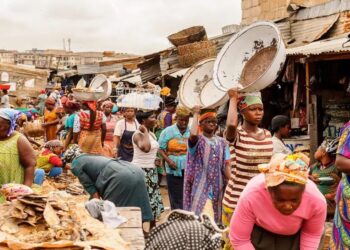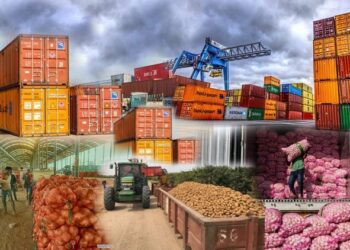Stakeholders concerns about Nigeria’s struggling automotive industry again, came to the fore as the National Bureau of Statistics (NBS) revealed that Nigerians imported N1.063 trillion worth of used vehicles in 2023. representing a remarkable increase of N736 billion or 226.46 per cent within a single year.
This substantial surge, compared to the N325.05 billion recorded in 2022, highlights significant efforts to address the supply shortage in the market.
Despite several initiatives aimed at propelling the sector’s growth, locally-manufactured cars remain outnumbered by imports, highlighting the sector’s underperformance relative to similar emerging economies.
The country’s automotive industry according to NBS, also commands less than 1 per cent of the global market share, reflecting a concerning trend for a nation with considerable economic potential.
NATIONAL ECONOMY findings showed that currently, the auto industry contributes only 0.04 per cent to Nigeria’s GDP, but its potential is much higher, estimated at 25 per cent of GDP.
Major players in the industry continue to navigate through turbulent waters amidst the sector’s downturn.
Official data paints a stark picture: Nigeria’s local production accounts for less than 10 per cent of the vehicles used within the country. While some companies, notably Hyundai and Honda, conduct assembly operations in Nigeria, the majority of vehicle parts are imported as knockdowns rather than being locally manufactured.
Implementation hurdles, including a substantial 70 per cent tariff hike on new vehicle imports by the National Automotive Design and Development Council (NADDC), have complicated efforts to bolster the sector.
The latest report from the Manufacturers CEOs Confidence Index underscores the challenges facing Nigeria’s vehicle manufacturing industry.
Activities within motor vehicles and miscellaneous assembly have plummeted to 46.7 points, primarily due to subsidy removal, dwindling sales, and diminished consumer purchasing power.
These setbacks have precipitated a decline in capacity utilisation, which dropped by 5.6 per cent, compelling local assemblers to downsize their workforce and resulting in negative readings across key performance indicators.
Volume of production plummeted by 6.1 per cent, signaling a significant downturn in manufacturing output within the automotive industry.
This decline is mirrored in the sector’s investment landscape, with a negative change of 5.6 per cent recorded in investment activities.
Additionally, the volume of sales witnessed a sharp decrease of 6.3 per cent, indicating weakened consumer demand and purchasing power.
The country’s annual vehicle demand stands at a staggering 720,000 units, local production can only supply a mere fraction, approximately 14,000 units.
Despite its minimal current contribution, the industry employs approximately ten thousand workers, with the capacity to employ up to 300,000 individuals.
Given this reliance on imports, particularly used cars, which account for 97 per cent of imports, stakeholders said the current situation is unsustainable.
The federal government’s Automotive Policy of 2014 (NAIDP 2014) was geared towards providing a framework that would support automobile companies to boost local content and establish a vehicle financing scheme that would provide funds for citizens to buy new cars.
However, despite the policy, the government’s refusal to patronise locally – manufactured vehicles, coupled with poor regulations, has constituted an albatross on the neck of the industry.
Despite the industry’s challenges, the NAIDP 2014, made significant progress under the leadership of the former director-general of NADDC, Jelani Aliyu.
Notably, the policy bolstered the sector by attracting $1billion in foreign direct investment, increasing the number of assembly plants to 30, capable of assembling 400,000 vehicles annually, and generating over 50,000 direct and indirect jobs.
It also initiated various programs and initiatives, including the establishment of twenty (20) Automotive Training Centers nationwide.
Additionally, it facilitated the ongoing development of three Automotive Industrial Parks and three Automotive Testing Centers and Laboratories.
These initiatives aimed to facilitate infrastructure sharing among producers and assemblers for the testing and certification of vehicles and automotive components.
Furthermore, the policy facilitated the commencement of electric vehicle assembly, such as the Hyundai Kona EV, and the development of four Pilot Solar Powered Electric Vehicle Charging Stations.
But despite these modest achievements, Nigeria still ranks the third-highest importer of used vehicles from the US, behind the United Arab Emirates (UAE), and China and only struggles to corner a mere less than1 per cent share of the global auto market.
Statistics also showed that the country imported 99 per cent of its used vehicles from the US valued at N721.79 billion, followed by the UAE at N2.12 billion, and Belgium at N1.52 billion.
Imports from Italy and Canada were valued at N1.41 billion and N1.18 billion, respectively.
In stark contrast, countries like South Africa and Morocco have showcased remarkable achievements in automotive manufacturing, serving as beacons of success in the African region.
In South Africa, the automotive sector is a major economic driver, directly employing around 110,000 individuals in vehicle assembly and component manufacturing. Moreover, an additional 900,000 people are engaged across the entire automotive value chain, ranging from mining and farming to retail, insurance, and finance.
South Africa’s automotive prowess is underscored by its status as the leading producer and consumer of new vehicles in Africa, accounting for nearly half of the region’s production and approximately 40 per cent of its sales.
The automotive sector plays an indispensable role in the nation’s economic landscape, supported by a robust local supply chain comprising over 500 entities.
Meanwhile, Morocco has emerged as a significant player in Africa’s automotive landscape, leveraging deliberate policies and strategic infrastructure projects such as the Tangier-Med port and the establishment of a 175,000-unit Complete Built-Up (CBU) plant by global OEM Renault.
These initiatives have propelled Morocco into a regional automotive hub, evidenced by the rebound of its automotive sector in 2021 despite the lingering effects of the COVID-19 pandemic.
With approximately 403,000 vehicle units produced, Morocco’s automotive industry has generated a total of 83,845 jobs, reflecting the nation’s dedication to automotive excellence and ambitious targets, including the aim to manufacture 1 million vehicles by 2025.
Recognising the need for strategic interventions to revitalise Nigeria’s automotive sector, the federal government initiated a comprehensive review of the National Automotive Industry Development Plan (NAIDP) 2014.
This review process, prompted by stakeholder concerns, aimed to address current challenges and lay the groundwork for sustained growth and innovation within the automotive sector.
NADDC report obtained by NATIONAL ECONOMY showed that the NAIDP 2023, targets the production of 200,000 passenger and commercial vehicles within the country, with the aim of securing a regional market share of 26 per cent.
Central to the plan is the emphasis on the use of Completely Knocked Down (CKD) mode of manufacturing, aiming to incorporate local content at a rate of 40 per cent in manufacturing processes. Additionally, the plan aims to maintain a production ratio of 30 per cent electric vehicles to combustion engine vehicles, aligning with global trends towards sustainable transportation solutions.
Furthermore, the NAIDP anticipates significant employment opportunities within the automotive sector, with direct hiring projected to range from 33,000 to 54,000 individuals.
Indirectly, the sector is expected to generate employment for between 600,000 to 1,000,000 people through associated industries and services, contributing to job creation and economic growth.
The report indicates that reaching a production target of 200,000 units by 2033 would require significant investment estimated to be between $6.3 to $15.8 billion across various channels.
Funding for the NAIDP 2023, the report showed would be sourced from 50 per cent of the import duty charged on all auto vehicles and components, budgetary allocation, donor funding, and vehicle finance schemes.
Since its review, the Nigerian Automotive Industry Development Plan (NAIDP) has remained in the spotlight, drawing special attention from various stakeholders.
During a public sector engagement focusing on the implementation of the NAIDP 2023-2023, stakeholders highlighted the opportunity presented by the recently-signed African Continental Free Trade Area (AfCFTA) Agreement in 2019, emphasising Nigeria’s potential to become a hub for automobile and automotive components manufacturing for the African markets, they, however, argued that challenges such as infrastructure gaps, smuggling, and policy inconsistency must be addressed to realise the industry’s full potential.
Chairman of the Nigeria Automotive Manufacturers Association (NAMA), Mr. Bawo Omagbitse, pledged the support of NAMA members to NADDC, affirming their commitment to work closely with the Council to ensure the successful implementation of the policy document.
Assistant comptroller Muazu Zanna, representing the comptroller general of the Nigerian Customs Service, assured NADDC of the Customs Service’s support in implementing the NAIDP.
Other government authorities, including representatives from the Central Bank of Nigeria (CBN), the Federal Road Safety Corps (FRSC), the African Continental Free Trade Area (AfCFTA), the Bank of Industry, the Federal Ministry of Transport, the Directorate of Road Traffic Services (DRTS), and the Standards Organization of Nigeria (SON), also participated in the engagement, offering positive contributions and support for the policy.
An industry insider, speaking on condition of anonymity, revealed to NATIONAL ECONOMY that the underperformance of Nigeria’s steel industry is also adversely affecting the production of parts necessary for manufacturing vehicle spare parts within the country.
The insider highlighted a concerning trend where companies increasingly opt to import Fully Built Units (FBUs) rather than assembling vehicles in Nigeria. This shift in preference, he said, is reflected in the operation of fewer than six assembly plants in the country.
He, therefore, urged the federal government to speed up the completion of the Ajaokuta Steel Complex if it was really serious about implementing the NAIDP 2023 within a span of 10 years.
Echoing similar sentiments, a source from a major local vehicle assembling company, also requesting anonymity, attributed the sector’s challenges to the lack of patronage from the government.
The source emphasised the importance of government support, citing examples from countries like China where government patronage plays a crucial role in fostering industrial growth.
He expressed a cautious outlook on the government’s commitment to translating rhetoric into tangible action steps that would propel the nation’s automotive sector forward.
According to him, at a mere 1 per cent, the country’s position in the global auto market is pitiable.





